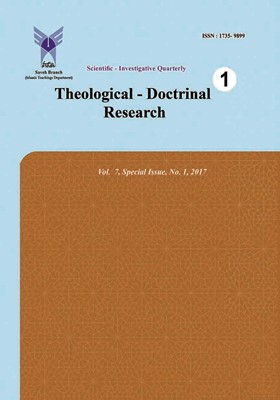Origin and approach of knowledge and innate religious art
Subject Areas : Islamic theology
Keywords: art, Psychology, religious art, perfection,
Abstract :
Of course, the most obvious cause of human excellence and perfection of finding and reaching the place where the human nose as she defines peak and end of life. Art is one of the areas in which human beings throughout history in order to express their aspirations and also in the way it used to achieve those aspirations is. With regard to the art world and of human thought and time and place of his environment as well as its goals and focus on different aspects of spirituality and spiritual issues to focus on the materiality mere mention fluctuate. . The aim of this paper is to explain relationship with his or her art and in particular the role that art plays to religious and spiritual perfection, he has been developed and growth. The findings show art based on the principles of religion, background and provides the perfect atmosphere maturity and perfection. In fact, the art inspired by the principles of religion and conscience is able to create an atmosphere that people understand the essence of things and concepts. The first feature of the space is free of any matter other than God and the believer heart ensure and Strengthen.
قرآن کریم
نهج البلاغه
اعوانی، غلامرضا. ( 1375 ). حکمت و هنر معنوی (مجموعه مقالات). انتشارات گروس .
امامی جمعه، سیدمهدی. ( 1388 ). فلسفه هنر در عشق شناسی ملاصدرا. تهران : ترجمه و نشر آثار هنری متن.
آوینی ، سید محمد. (1370 ). جاودانگی و هنر (مجموعه مقالات). انتشارات برگ.
بستانی ، محمود. ( 1378 ). اسلام و هنر. ترجمه ی حسین صابری. مشهد : آستان قدس رضوی .
بورکهارت، نیتوس. (1369 ). هنر مقدس. ترجمه جلال ستاری. تهران: سروش.
پورحسن درزی، قاسم و پریوش کوششی. ( 1388 ). بحثی پیرامون هنر دینی. فصلنامه ی رهیافت انقلاب اسلامی. شماره ی 11. صص 18-3.
تشکری،فاطمه. ( 1390 ). نماد پردازی در هنر اسلام. مجله اطلاعات حکمت و معرفت. شماره ی 66. صص 34 تا 39 .
تولستوی، لئون. (1345 ). هنر چیست؟. ترجمه ی کاوه دهگان. تهران : سپهر.
جعفری، محمد تقی. (1378 ). هنر و دین از دیدگاه علامه جعفری. مجله ی هنر دینی. شماره ی 10.
جوادی آملی، عبدالله. ( 1375 ). هنر و زیبایی از منظر دین. ویرایش سید علاءالدین طباطبایی و سید احمد پایداری.
حسن زاده آملی، حسن. (1377 ). انسان در عرف عارفان. تهران : سروش.
حسن زاده آملی، حسن. (1374 ). قرآن، عرفان و برهان از هم جدایی ندارند. فهم. قیام.
دهخدا،علی اکبر. (1377 ). لغت نامه. تهران : موسسه انتشارات و چاپ دانشگاه تهران.
شلکنز ، الیزابت. ( 1393 ). هنر مفهومی و دست ساخته. ترجمه ی بیتا شمسینی. تهران : ققنوس .
طاهری، حبیب الله. (1388). نقش باورهای دینی در رفع نگرانی ها . زائر / آستانه مقدسه. قم.
لاکست، ژان. ( 1393 ). فلسفه ی هنر. ترجمه ی محمدرضا ابوالقاسمی. تهران : نشر ماهی .
مددپور، محمد. ( 1384 ). آشنایی با آرای منتظران درباره ی هنر. تهران : سوره ی مهر .
مددپور، محمد. (1390 ). تجلیات حکمت معنوی در هنر اسلامی. تهران : امیرکبیر .
مهرپویا، حسین و مرضیه قاسمی. ( 1387 ). تمایز هنر دینی و هنر قدسی در آراء متفکران معاصر. مجله ی هنر و معماری (رهپویه ی هنر). شماره ی 6 . صص 15-10.
نصر، سید حسین. (1371 ). هنر و معنویت اسلامی. ترجمه ی محمد سعید حنایی کاشانی. فصلنامه هنر.
نوروزی طلب، علی رضا. (1388 ). کتاب ماه هنر : کتابداری ، آرشیو و نسخه پژوهی. شماره ی 129. صص 31-4.
هگل، گئورگ ویلهلم فریدریش. (1363 ). مقدمه بر زیبایی شناسی. ترجمه ی محمد عبادیان. تهران : آوازه . هنفلینگ، اسولد. (1377 ). چیستی هنر. ترجمه ی علی رامین. تهران : هرمس.
Bagheri,K,(2008). An introduction to Islamic philosophy of education, Tehran, Elmi farhangi press, Vol (1), pp3-130.
Broudy, Harry, (1977). "How Basic is Aesthetic Education? Or Is, Rt the Fourth R?" - Educational Leadership. Vol 35(2) .139
Haling, D & Reginald, J, (2005), History of west philosophy, translated by Abdolhossein Azrang. Tehran, Ghoghnoos Publication, fifth edition. (2005)
https://philosophynow.org/issues/108/What_is_Art_and_or_What_is_Beauty
Plato.(2006).The Republic, translator: Fuad Rouhani, Eighth Edition,Tehran: Elmi – farhangi Publications. (In Persian(

